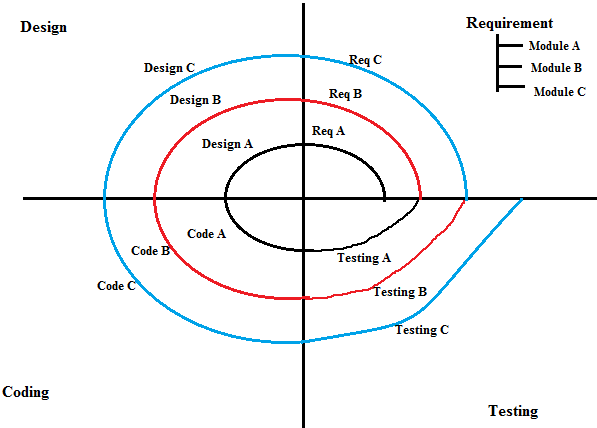Introduction to software development life cycle (SDLC)
Chapters
Spiral Model
Whenever the models are dependent on each other, in this case we develop the application part by part. For example: An application is divided into modules called module A, B, C, Spiral model is flexible for requirement changes. A software project repeatedly goes through each phases in iterations hence it is called spiral. By using spiral model customer can use the product at early stage.
Spiral Model:

In the spiral model the requirement is divided into sub modules as shown in above diagram these modules are depending on each other. For Module-A there will be separate requirement, design, coding, and testing, and each and every module will goes through these phases cycle.
How to handle changes in spiral module?
Minor changes (these changes will not impact on the functionality of the application):
In case of minor changes we do not go for separate cycle, where as we combine it with next module in same cycle.
Major changes (these changes will impact on the functionality of the application):
In case of major changes we do go for separate cycle, since it may have impact on existing functionalities.
Example for major changes:
Major Changes in A hence it taking separation iteration as shown below.

When to use Spiral model:
- Whenever there is long-term project then spiral model is useful
- Whenever user are not sure about their requirements
- When it is new product line
- If project is mission critical
- For medium to high-risk projects
Advantages of Spiral model:
- Flexible for changes: Any time can requirement changes are possible
- Since it is module to module development, clarity in process
- Customer can use the product at early stages at least the basic models
- Since customer can get the product hence there will be approval and documentation control.
- Additional Functionality can be added at a later date.
Disadvantages of Spiral model:
- It is not suitable for short-term projects
- There are no parallel deliverables
- Can be a costly model to use
- If there is major issue time consumption will be more
In the next chapter we will discuss about the Prototype model
Description
This tutorial covers
- What is SDLC
- Waterfall Model
- Spiral Model
- Prototype Model
- V-Model
- Iterative model
- Big Bang Model
- RAD Model
- Agile Model
- Useful resources to futher your understanding on SDLC
Report any errata directly using our support forms
Audience
Beginners looking to get their hands on understanding of software development life cycle (SDLC)
Learning Objectives
A quick introduction to SDLC
Author: Subject Coach
Added on: 30th Jul 2015
You must be logged in as Student to ask a Question.
None just yet!